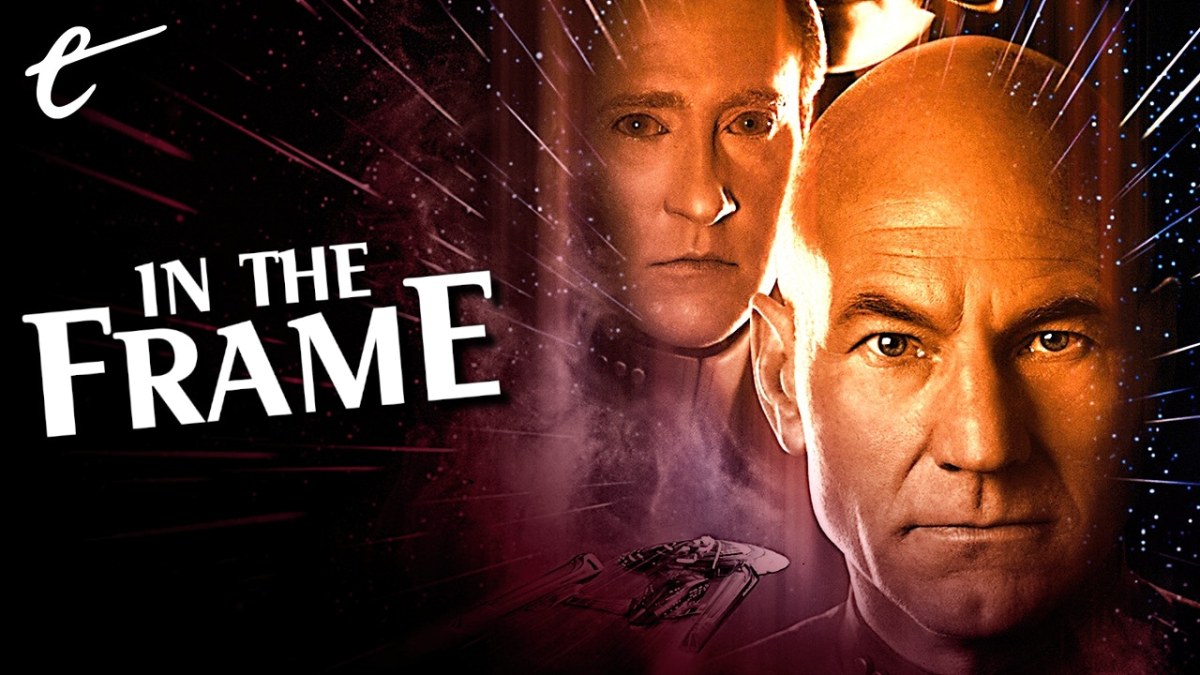This November marks the 25th anniversary of Star Trek: First Contact, the second film starring the cast of Star Trek: The Next Generation. It also marks the 35th anniversary of Star Trek IV: The Voyage Home, the fourth movie starring the original cast. Next June will mark the 40th anniversary of Star Trek II: The Wrath of Khan. It’s interesting how these three movies exist in conversation with one another, fueling a battle for the franchise’s soul that spanned more than three decades.
Star Trek: The Motion Picture had been a commercial success but a critical disappointment. The film was often compared (unflatteringly) to 2001: A Space Odyssey. Writer Harlan Ellison famously described it as “the Motionless Picture.” Time has perhaps been kind to The Motion Picture, with Robert Wise’s director’s cut coming to Paramount+ soon. However, at the time, it was decided that the franchise needed a new direction for the sequel.
The Wrath of Khan was a breath of fresh air. On a much lower budget than The Motion Picture, it benefited from the direction of franchise outsider Nicholas Meyer. Meyer anchored the film in the franchise’s nautical metaphor, reframing “Horatio Hornblower in outer space” as a futuristic riff on Moby Dick. It found genetically engineered villain Khan Noonien Singh (Ricardo Montalban) avenging himself on Captain James T. Kirk (William Shatner).
The film performed well at the box office, earning slightly less than The Motion Picture but also offsetting that against a much lower budget. More to the point, The Wrath of Khan quickly became a beloved classic. While initially fans had been hostile to the very idea of the film, they quickly rallied behind it. The Wrath of Khan is commonly regarded among fans as “the best of the Trek movies.” Moments of the film have become genuinely memetic. It became a fetish object for fans.

The Wrath of Khan kicked off a loose trilogy of movies that continued through the sorely underappreciated The Search for Spock and concluded with The Voyage Home. While The Wrath of Khan was a solemn meditation on vengeance, The Voyage Home was a goofy comedy about the characters traveling back in time to 1986 in order to literally “save the whales.” It’s a movie that dedicates an entire sequence to Pavel Chekov (Walter Koenig) mispronouncing “vessels.”
Audiences loved The Voyage Home. It became the first Star Trek movie to gross over $100 million and went on to become the seventh-highest grossing movie of the year. It was one of only 52 movies between 1982 and 2011 to receive an A+ CinemaScore. By his own admission, director Leonard Nimoy had set out to make a movie that was “more accessible for a non-Star Trek audience,” and reviews suggested that all but the most ardent non-fans would find “something to enjoy.”
The Voyage Home was essentially Star Trek for mass audiences. It also marked the point at which Paramount began seriously considering bringing Star Trek back to television. It makes sense that The Voyage Home would become a touchstone for the relaunch of Star Trek. In the early years of The Next Generation, the producers were eager to build Star Trek for general viewers rather than specifically for fan audiences.
Writer Ira Steven Behr had to fight to convince Gene Roddenberry and Rick Berman to sign off on the inclusion of the name “Spock” in the episode “Sarek.” When Brannon Braga confessed that he was not a die-hard Star Trek fan, Roddenberry advised against going back and watching the original Star Trek. (Braga eventually did watch it.) Like bringing in Meyer on The Wrath of Khan, it was important to maintain an outside perspective on the franchise.

Although people often talk about Star Trek as a cult franchise, The Next Generation was not a cult hit. It was a cultural phenomenon. By the time it ended, it was “one of the most popular weekly shows on television and easily one of the most profitable.” While later spin-offs, including Star Trek: Voyager and Enterprise, would become cult objects, The Next Generation was a beloved cultural institution. It even picked up a “big surprise” Emmy nomination for Outstanding Drama Series in its final season.
The Star Trek of that era was largely derived from The Voyage Home. In the middle of the 1990s, each of the three Star Trek spin-offs all did obvious riffs on the time-traveling-to-Earth-history fish-out-of-water story. The season-bridging two-parter “Time’s Arrow” on The Next Generation sent the crew back to 19th century San Francisco. On Deep Space Nine, the late third season two-parter “Past Tense” has recently been reappraised as one of the franchise’s greatest moments.
Sometimes these stories represented a direct rejection of The Wrath of Khan. In its third season, Voyager sent the crew back to 1996 for the “Future’s End” two-parter. In Star Trek continuity, this time period was supposedly the height of the so-called “Eugenics Wars” waged by Khan Noonien Singh. However, there was no mention of the conflict in the comedic adventure. Even The Star Trek Encyclopedia glibly acknowledged the continuity snafu.
Star Trek: First Contact was released just weeks after “Future’s End” was broadcast. The film’s plot was superficially similar to that of The Voyage Home. During an attack on Earth by an alien menace, the crew of the Enterprise find themselves thrown back in time. More specifically, Commander William T. Riker (Jonathan Frakes) finds himself embroiled in a comedic adventure involving the warp pioneer Zefram Cochrane (James Cromwell) that finds the away team as fish out of time.

However, this was the B-plot of First Contact. The driving plot was a story of obsession and revenge, with Captain Jean-Luc Picard (Patrick Stewart) trying to avenge himself on the Borg for their past violence against him. He only comes to his senses when Lily Sloane (Alfre Woodard) points out that he is essentially living a futuristic riff on Moby Dick. It was recognizable as an attempt to do The Wrath of Khan with the cast of The Next Generation.
First Contact was a massive success. Roger Ebert ranked it alongside The Voyage Home as one of the best films in the franchise. Kenneth Turan brought up both The Wrath of Khan and The Voyage Home in his review for The Los Angeles Times. However, First Contact seemed to establish a new hierarchy within the franchise. The Voyage Home was no longer the model for the future of Star Trek, but would take a back seat to The Wrath of Khan in terms of influence.
In the years that followed First Contact, the franchise was suddenly dominated by episodes and stories riffing on The Wrath of Khan. On Deep Space Nine, Benjamin Sisko (Avery Brooks) got his own story of space obsession in “For the Uniform,” although that quoted Les Misérables rather than Moby Dick. On Voyager, Kathryn Janeway (Kate Mulgrew) got her own equivalent in the epic two-parter “Year of Hell.” Voyager even more explicitly riffed on Moby Dick in the episode “Bliss.”
It was even more obvious looking at the feature film franchise. Two of the next three feature films after First Contact drew heavily on The Wrath of Khan. The last movie featuring the Next Generation cast, Nemesis, ported over a lot of “the imagery and plot ideas” of The Wrath of Khan, with none of the depth. Like The Wrath of Khan, Nemesis was a story about a villain (Tom Hardy) obsessed with the protagonist, culminating in a nebula battle and the sacrifice of a beloved crewmember.

The franchise didn’t just lean into the plot and themes of The Wrath of Khan. It also began to lean into the mythology. On Deep Space Nine, “Doctor Bashir, I Presume” revealed that Julian Bashir (Alexander Siddig) was a genetically engineered human, like Khan. He would work with other augmented humans in “Statistical Probabilities” and “Chrysalis.” Enterprise would build a three-part “Augment” trilogy around the legacy of Khan and later tie his DNA to Klingon forehead ridges.
While many of these individual stories were good, they also overlapped with a period of decline for the franchise as Star Trek became more insular. Viewership dwindled, Nemesis bombed, and the press grew increasingly hostile. However, even the first of the Abrams reboot movies, simply titled Star Trek, drew heavily from The Wrath of Khan, showing how Kirk (Chris Pine) beat the Kobayashi Maru test introduced in that earlier film and featuring another obsessive avenging villain (Eric Bana).
Perhaps Star Trek Into Darkness was the culmination of a trend that had been building in the 17 years since the release of First Contact. Abrams’ sequel was effectively a loose remake of The Wrath of Khan, down to actually featuring the character Khan Noonien Singh (Benedict Cumberbatch) for the first time in over three decades. The movie borrowed key images and even key quotes from The Wrath of Khan. This attracted a lot of criticism, including from Meyer himself.

However, there might be something to be said for Into Darkness drawing so directly from The Wrath of Khan. If nothing else, it ripped the Band-Aid off. It committed to something the Star Trek franchise had been teasing for nearly two decades and just remade The Wrath of Khan. Incidentally, while some fans have been vocal in their hatred of it, British polling of general audiences suggests Into Darkness is more popular with adults, Millennials, Generation X, and women than The Wrath of Khan.
Into Darkness felt like an exorcism of The Wrath of Khan. The next film in the series, Star Trek Beyond, drew more heavily from Star Trek III: The Search for Spock. Star Trek: Discovery would take its cues from episodes like “The Devil in the Dark” or “Mirror, Mirror.” Star Trek: Picard would draw from “The Measure of a Man” or “I, Borg.” The most significant reference to The Wrath of Khan in modern Star Trek was a spoof of the movie franchise in the Lower Decks episode “Crisis Point.”
The Wrath of Khan is rightly regarded as one of the best pieces of Star Trek ever produced. It is a superb piece of cinema. However, in the decade and a half following First Contact, the franchise became obsessed with emulating the thrills and continuity of that second film. However, it’s worth marking the anniversaries of both The Voyage Home and First Contact by remembering that Star Trek is more than just The Wrath of Khan.





